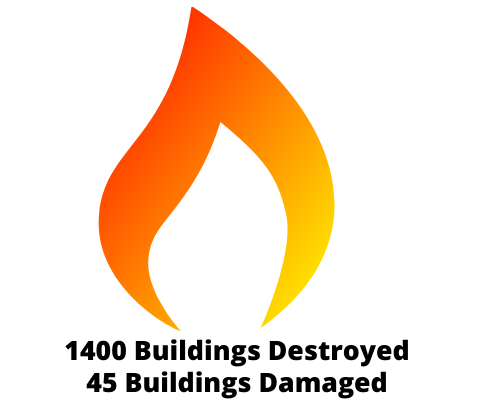On July 13, 2021, the second-largest wildfire in the history of California started and burned out of control for more than three months. By the time firefighters 100 percent contained it on October 25, it had burned 963,309 acres over five counties: Butte, Plumas, Lassen, Shasta, and Tehama.
After an extensive investigation, CAL FIRE blamed the cause of the blaze on a Pacific, Gas, and Electric (PG&E) power line that had come into contact with a Douglas fir tree.
Fast forward to early April 2022. Five Northern California district attorneys came to a settlement agreement with PG&E that allows the utility provider to avoid criminal prosecution for the Dixie Fire.
Although the settlement requires the utility company to pay fines and compensation, it allows PG&E to avoid criminal culpability.
The district attorneys who participated in the negotiation see the settlement as a victory. However, many people, including victims of past fires caused by PG&E, view the agreement as a mistake with dangerous consequences. Our Dixie Fire Attorneys discuss the intricacies with this settlement below.
PG&E: A Repeat Felony Offender
PG&E’s history with community-destroying disasters is long. A review of the utility’s record since 2010 reveals repeat felony offenses with multiple homicide convictions. As such, its recent settlement with the Northern California district attorneys has surprised and upset many people.
2010 San Bruno Gas Explosion
On the morning of September 9, 2010, an explosion erupted in residential San Bruno. Leaking natural gas from a 28-foot section of underground piping had ignited and eventually killed eight people and destroyed 38 homes.
According to the National Transportation Safety Board (NTSB), PG&E’s negligent installation and maintenance of gas pipes probably caused the Dixie fire. The federal grand jury of the United States District Court for the Northern District of California in April 2014 subsequently indicted PG&E.
In July of the same year, the utility was indicted again, this time on obstruction of justice charges for providing false information to the NTSB during its investigation.
PG&E was eventually placed on felony probation until 2022 and paid out $1.6 billion and $3 million in fines.
2018 Camp Fire
The 2018 Camp Fire destroyed 153,336 acres and 18,804 structures. But the most egregious outcome was the toll on human life. The fire killed 85 civilians, making the Camp Fire California’s deadliest fire on record.
Once again, PG&E was directly implicated in the cause of a deadly blaze. CAL FIRE investigators found two ignition sites in Butte County, where they concluded that PG&E power lines ignited dry vegetation.
In June 2020, PG&E pleaded guilty to 84 separate counts of involuntary manslaughter. Bill Johnson, PG&E president, confessed in court that the utility’s equipment started the fire.
The grand jury report stated that PG&E demonstrated “a callous disregard for the safety and property of the citizens of Butte County.”
The report also stated:
There are almost 50,000 victims of the Camp Fire. All of those people relied upon PG&E to provide safe electric power. Despite years of extreme drought, consistently high down canyon winds, and the knowledge equipment failure on high voltage transmission lines can cause fires, PG&E ignored warning signs and did the absolute minimum to mitigate the fire danger.
2020 Zog Fire
The Zog Fire began on September 27, 2022, and firefighters contained it 16 days later. It affected Shasta and Tehama Counties and destroyed over 56,000 acres. It completely destroyed 204 structures, and four people lost their lives.
According to the Shasta County District Attorney, evidence shows that power lines owned by PG&E ignited a tree that the utility should have removed in 2018.
Based on that evidence, the Shasta County DA filed 11 felony charges against PG&E. It is currently in litigation as of May 2022.
The 2021 Dixie Fire
 From its beginning on July 13, 2021, California’s second-largest wildfire taxed emergency resources beyond their capacity. In total, the blaze scorched nearly one million acres, leaving 1,400 destroyed buildings and 95 others damaged. Thousands of people battled the fire around the clock for months on end until they finally contained it on October 25, 2021.
From its beginning on July 13, 2021, California’s second-largest wildfire taxed emergency resources beyond their capacity. In total, the blaze scorched nearly one million acres, leaving 1,400 destroyed buildings and 95 others damaged. Thousands of people battled the fire around the clock for months on end until they finally contained it on October 25, 2021.
Although not the worst fire in California history, it comes on the heels of the worst blaze and just after the deadly 2018 Camp Fire. That it occurred so close in time to the Camp and Zog Fires demonstrates that PG&E habitually fails in its duty to provide safe electric service while turning substantial profits.
Once again, faulty power lines caused the Dixie Fire. In this case, a Douglas fir touched the lines, starting a fire at the base of the tree.
The Dixie Fire Settlement
The North State District Attorneys are the district attorneys from the five counties ravaged by the Dixie Fire: Plumas, Lassen, Tehama, Shasta, and Butte Counties. In lieu of criminal prosecution, the attorneys pursued a civil settlement that requires the utility to fulfill certain conditions for avoiding criminal prosecution.
The principal rationale behind foregoing criminal prosecution was to maximize the financial compensation for the fire’s victims. According to the North County DAs, the potential criminal fines PG&E would have to pay would max out at $329,417, whereas the settlement’s conditions will require payouts of over $100 million.
The Dixie Fire settlement is part of a double-settlement package offered to PG&E to avoid criminal charges. The other fire was the Kincade Fire, which started in Sonoma County on October 23, 2018. Although it only burned for 13 days, it destroyed 374 structures and burned nearly 78,000 acres. PG&E power lines caused it.
Conditions of the Dixie Fire Settlement
The Dixie Fire portion of the settlement contains some conditions aimed directly at people who have suffered home and personal property losses. The deal includes provisions for expedited direct payments for property losses.
The terms require that PG&E:
- Set up an expedited compensation procedure within 30 days
- Pay $400/square foot for loss of principal residences and $240,000 for mobile homes
- Pay $140/square foot for items destroyed in residences and $150,000 for those in mobile homes
- Pay $150/square foot for other structures destroyed
- Take no more than 30 days to verify or reject an offer
- Pay accepted offers within 30 days
- Create online resources to aid individuals in submitting claims
PG&E also must make good faith contributions to county nonprofit organizations that either helped fire emergency efforts or will help prevent future fires. The mandated amount is $29,500,000 and it must disburse the funds by July 12, 2022. PG&E may not pass this cost on to customers.
Other settlement conditions include $1 million in civil penalties payable to each district attorney’s office involved in the settlement, up to $15 million a year for five years for an independent safety monitor, and the implementation of assorted wildfire mitigation programs.
The PG&E Settlement Is Bad for Dixie Fire Victims
The North County DAs are touting the settlement as a victory. However, some feel the agreement lets the utility off the hook and does nothing to instill confidence that the company will promptly honor claims presented to it.
Camp Fire Victims Still Awaiting Payments
Victims of the Camp Fire were promised and deserved payments to help them rebuild their lives. However, they didn’t receive direct payments for their losses. Instead, a settlement tying victims’ compensation to the value of PG&E stock was concocted and approved, and a trust was established.
It was a $13.5 billion promise, funded equally with cash and stocks, that never fully materialized. In March 2021, the first fire victims to receive payment from the Fire Victim Trust (FVT) only received 30 percent of the claim amount, principally because the stock had lost significant value and lacked sufficient funds to honor claims.
In other words, the settlement probably won’t cover the losses experienced by the tens of thousands of members of the trust. It was a deal that roundly benefited PG&E more than the fire victims and forced them to own part of the company that failed them in the first place.
The Camp Fire settlement disaster casts serious doubt that the Dixie Fire claims process for fire victims will result in quick and adequate payouts as required in the settlement’s terms. If tens of thousands of previous PG&E victims have waited years for compensation, why believe Dixie Fire victims will get paid quickly?
Cash for Leniency
To some, the Dixie Fire settlement looks like a cash-for-leniency deal. Various advocates affected by the fire or who work directly with victims have stated their disdain for how PG&E used money to negotiate its way out of criminal penalties.
Because of this, they have little to no faith that PG&E will honor the settlement’s terms. Although the deal’s terms with the North State DAs are clear, so too were the provisions of the Camp Fire settlement, which is now seeing victims get only 45 percent of their promised compensation years after the parties agreed to settle.
Failure to Make Significant Changes
On January 26, 2022, PG&E’s probation from the San Bruno charges ended. U.S. District Judge William Alsup, charged with overseeing the company’s rehabilitation during probation, penned a report that unequivocally states that PG&E has fallen far short of adequate rehabilitation.
It says that during five years of probation, “PG&E has gone on a crime spree and will emerge from probation as a continuing menace to California.”
This failure to make significant changes and reckless operation of public utilities is precisely what caused the Dixie Fire and other fires that have ravaged California in recent years. The lack of reformative action is also a sign that the utility may not honor the full terms of the Dixie Fire settlement, neither in full nor promptly.
Recourse for Dixie Fire Victims
There is no doubt that PG&E has responsibility for the Dixie Fire. Fire victims deserve full and timely compensation. Although the Dixie Fire settlement contains provisions for timely compensation, PG&E’s behavior with past settlements casts doubts on the certainty of it fulfilling these provisions.
Fortunately, fire victims have options beyond the PG&E settlement.
If you were injured or faced property loss, you may have a valid claim against PG&E.
With the help of a lawyer, you can seek compensation for your injuries, including:
- Medical expenses
- Loss of income
- Costs for continuing medical care
- Emotional suffering and distress
You can also file a claim for your lost property, such as:
- Damaged or destroyed home
- Damaged or destroyed vehicle
- Loss of business
- Costs of evacuation and relocation
Keep all of your medical, repair, and income statements. Your lawyer can use them to substantiate your claim.
Dixie Fire Victims Deserve Timely Compensation
As a fire victim, your life was affected by terrible forces caused by the recklessness of a big utility company. You deserve the resources you need to rebuild your life.
PG&E failed to abide by settlement rules in the past and has left its previous fire victims holding on to hopes for a payout for far less than what it promised. There’s reason to doubt they will completely honor the terms of this deal.
As a victim, you can obtain compensation for your property losses through a legal claim. You can also hire a personal injury lawyer to get you the relief you need for your injuries. Even if you have insurance, your insurance payout will probably not cover all your losses.
For answers to your questions and a review of your case, you can arrange for a free consultation with a personal injury lawyer or a property damage attorney near you.
